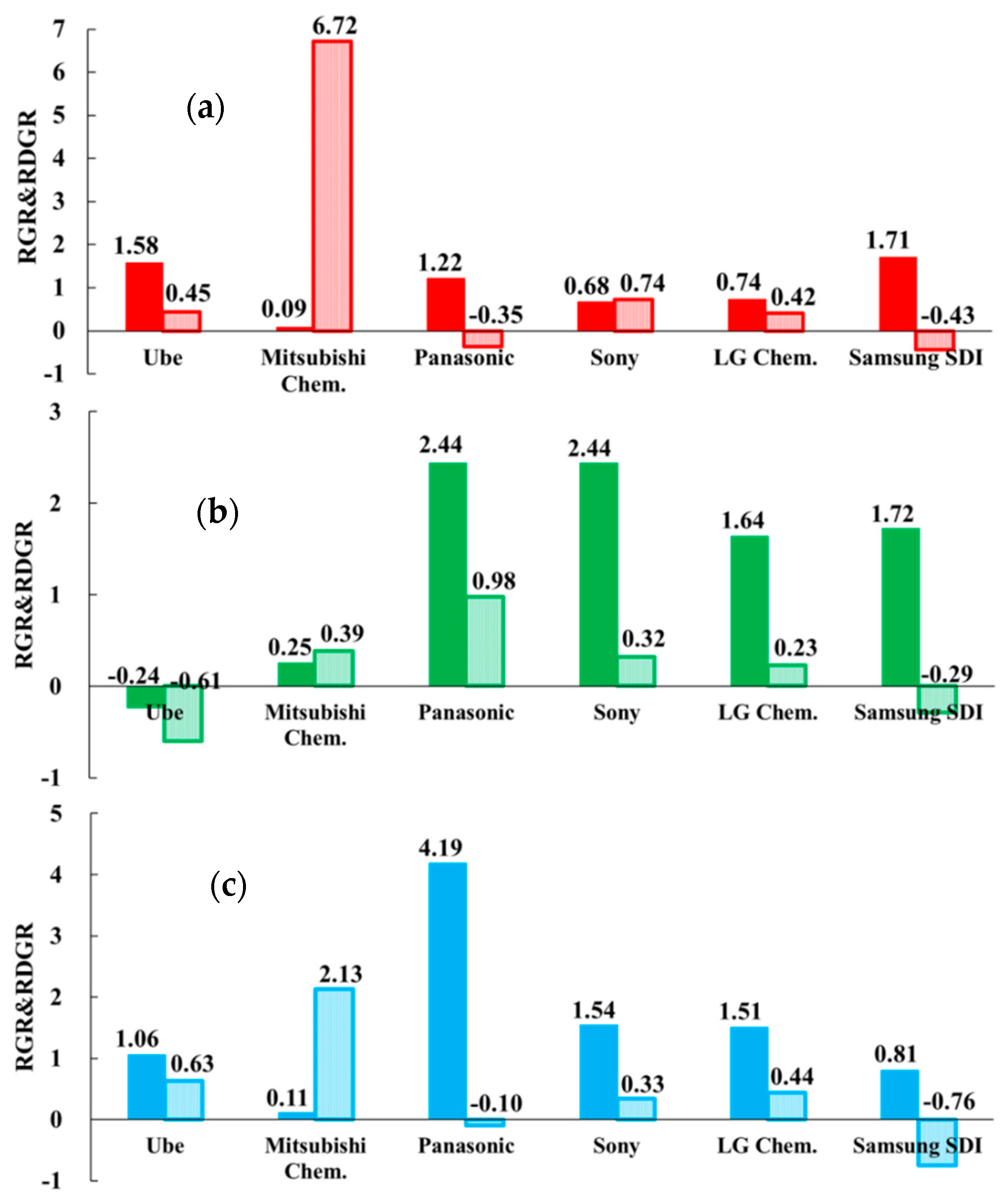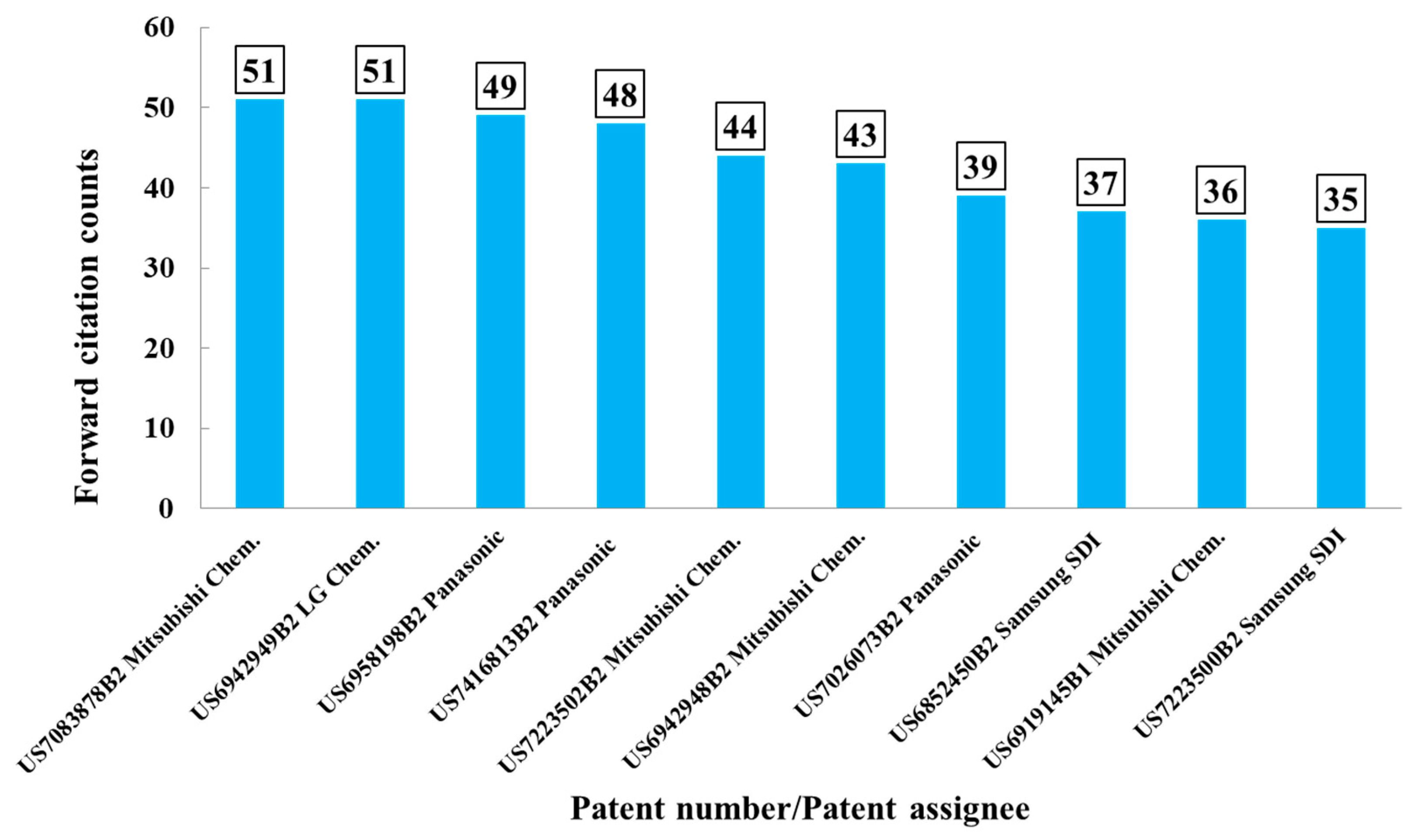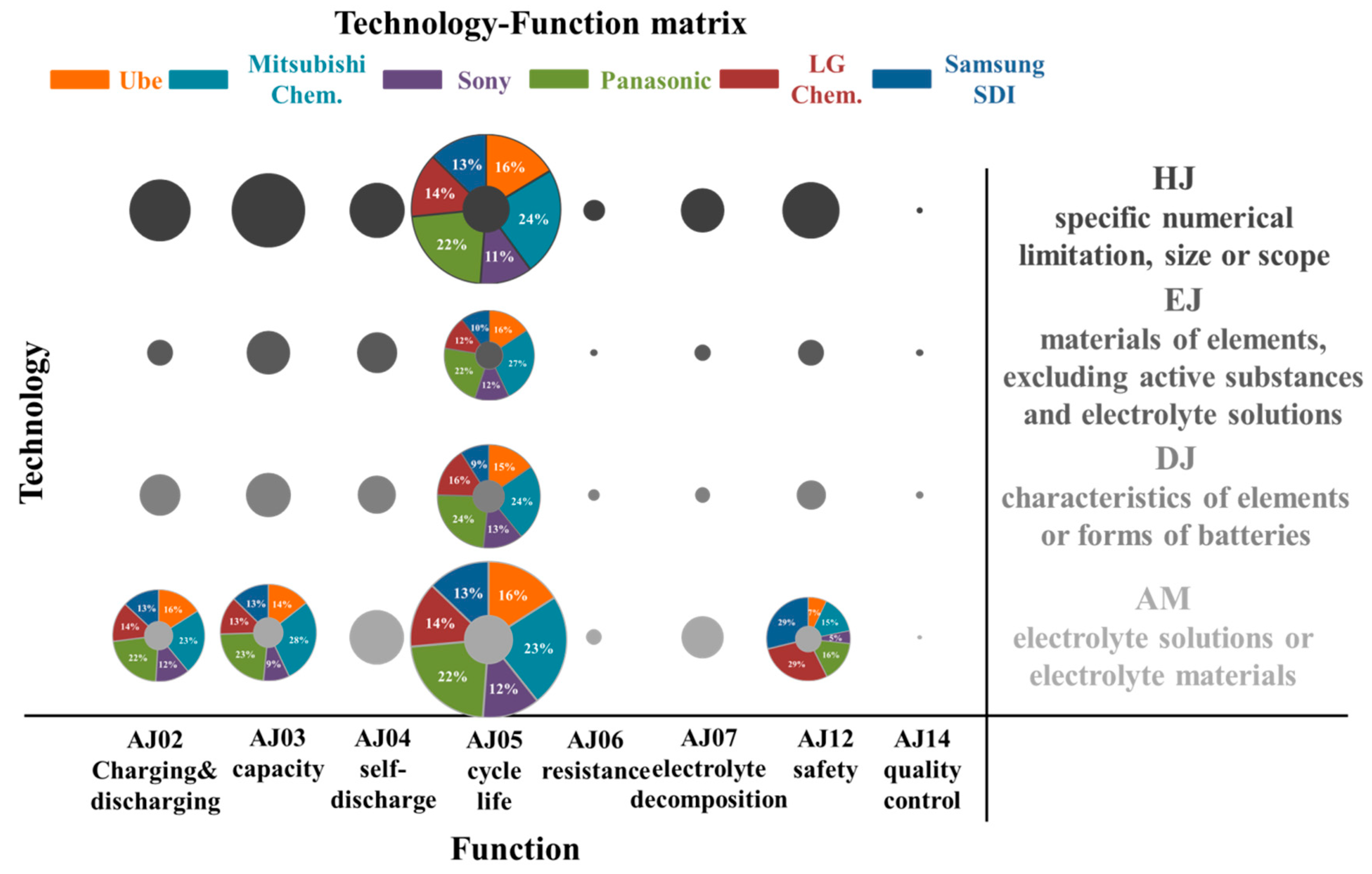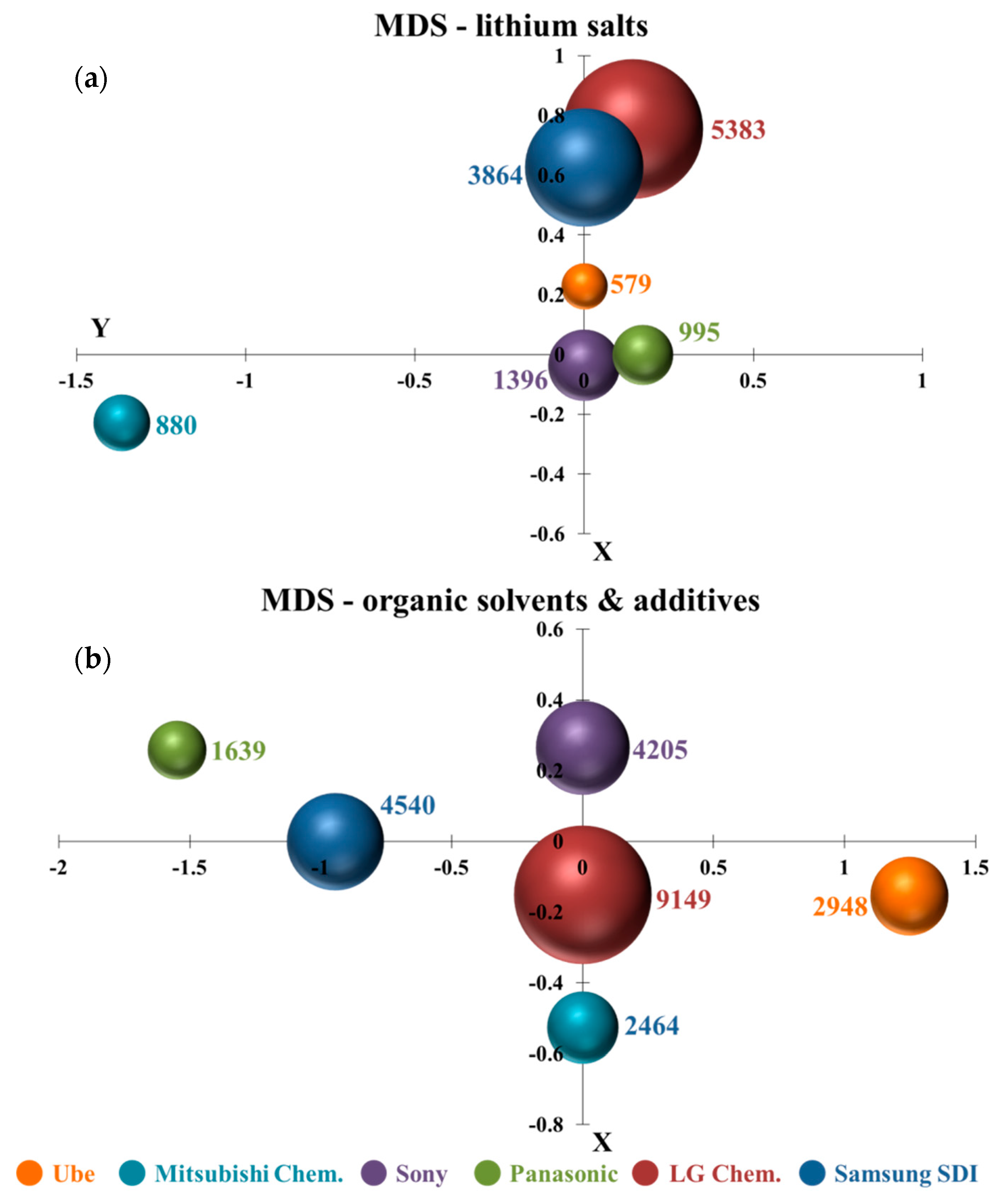Search for the Developing Trends by Patent Analysis: A Case Study of Lithium-Ion Battery Electrolytes
Abstract
1. Introduction
2. Methodology
2.1. Patent Information
2.2. Patent Indicators
2.2.1. RGR and RDGR as a Combined Indicator
2.2.2. RPP and RPA as a Combined Indicator
2.2.3. Citation Indicators
2.2.4. Technology-Function Matrix
2.2.5. Text Mining Analysis—Multidimensional Scaling (MDS)
3. Results
3.1. RGR and RDGR Combination Indicator
3.2. RPP and RPA Combination Indicator
3.3. The Forward-Citation Information
3.4. Technology-Function Matrix
3.5. Multi-Dimensional Scaling (MDS)
4. Discussion
4.1. Technological Innovation
4.2. Contribution to Research
4.3. Contribution to the LIBs Industry
5. Conclusions
Supplementary Materials
Author Contributions
Funding
Acknowledgments
Conflicts of Interest
References
- Tasaki, K.; Goldberg, A.; Lian, J.-J.; Walker, M.; Timmons, A.; Harris, S.J. Solubility of Lithium Salts Formed on the Lithium-Ion Battery Negative Electrode Surface in Organic Solvents. J. Electrochem. Soc. 2009, 156, A1019–A1027. [Google Scholar] [CrossRef]
- Wang, X.J.; Lee, H.S.; Li, H.; Yang, X.Q.; Huang, X.J. The effects of substituting groups in cyclic carbonates for stable SEI formation on graphite anode of lithium batteries. Electrochem. Commun. 2010, 12, 386–389. [Google Scholar] [CrossRef]
- Yan, J.; Zhang, J.; Su, Y.-C.; Zhang, X.-G.; Xia, B.-J. A novel perspective on the formation of the solid electrolyte interphase on the graphite electrode for lithium-ion batteries. Electrochim. Acta 2010, 55, 1785–1794. [Google Scholar] [CrossRef]
- Wang, F.-M.; Yu, M.-H.; Hsiao, Y.-J.; Tsai, Y.; Hwang, B.-J.; Wang, Y.-Y.; Wan, C. Aging Effects to Solid Electrolyte Interface (SEI) Membrane Formation and the Performance Analysis of Lithium Ion Batteries. Int. J. Electrochem. Sci. 2011, 6, 1014–1026. [Google Scholar]
- Wang, M.-Y.; Chang, D.-S.; Kao, C.-H. Identifying Technology Trends for R&D Planning Using TRIZ and Text Mining. RD Manag. 2010, 40, 491–509. [Google Scholar]
- Qu, Z.; Zhang, S.; Zhang, C. Patent research in the field of library and information science: Less useful or difficult to explore? Scientometrics 2017, 111, 205–217. [Google Scholar] [CrossRef]
- Glanzel, W.; Meyer, M. Patent cited in the scientific literature: An exploratory study of ‘reverse’ citation relations. Scientometrics 2003, 58, 415–428. [Google Scholar] [CrossRef]
- Meyer, M. Tracing knowledge flows in innovation systems. Scientometrics 2002, 54, 193–212. [Google Scholar] [CrossRef]
- Narin, F. Patent Bibliomatrics. Scientometrics 1994, 30, 147–155. [Google Scholar] [CrossRef]
- Wagner, R.; Preschitschek, N.; Passerini, S.; Leker, J.; Winter, M. Current research trends and prospects among the various materials and designs used in lithium-based batteries. J. Appl. Electrochem. 2013, 43, 481–496. [Google Scholar] [CrossRef]
- Golembiewski, B.; Vom Stein, N.; Sick, N.; Wiemhöfer, H.-D. Identifying trends in battery technologies with regard to electric mobility: Evidence from patenting activities along and across the battery value chain. J. Clean. Prod. 2015, 87, 800–810. [Google Scholar] [CrossRef]
- Pilkington, A.; Dyerson, R.; Tissier, O. The electric vehicle: Patent data as indicators of technological development. World Pat. Inf. 2002, 24, 5–12. [Google Scholar] [CrossRef]
- Ernst, H. Patenting strategies in the German mechanical engineering industry and their relationship to company performance. Technovation 1995, 15, 225–240. [Google Scholar] [CrossRef]
- Ernst, H. Patent portfolios for strategic R&D planning. J. Eng. Technol. Manag. 1998, 15, 279–308. [Google Scholar]
- Yuan, M.S.; Liang, C.C. The Study of Development of Patent Indexes. J. Libr. Inf. Sci. 2009, 35, 88–106. [Google Scholar]
- Altuntas, S.; Dereli, T.; Kusiak, A. Forecasting technology success based on patent data. Technol. Forecast. Soc. Chang. 2015, 96, 202–214. [Google Scholar] [CrossRef]
- Yang, G.-C.; Li, G.; Li, C.-Y.; Zhao, Y.-H.; Zhang, J.; Liu, T.; Chen, D.-Z.; Huang, M.-H. Using the comprehensive patent citation network (CPC) to evaluate patent value. Scientometrics 2015, 105, 1319–1346. [Google Scholar] [CrossRef]
- HansjoKrg, K.; Joachim, M.B. Data visualization by multidimensional scaling: A deterministic annealing approach. Pattern Recognit. 2000, 33, 651–669. [Google Scholar]
- Lo, S.C. Patent coupling analysis of primary organizations in genetic engineering research. Scientometrics 2007, 74, 143–151. [Google Scholar] [CrossRef][Green Version]
- Mohammadi, E. Knowledge mapping of the Iranian nanoscience and technology: A text mining approach. Scientometrics 2012, 92, 593–608. [Google Scholar] [CrossRef]
- Schmoch, U. Evaluation of technological strategies of companies by means of MDS maps. Eval. Res. Innov. 1995, 10, 426–440. [Google Scholar]
- Zhang, S.S. A review on electrolyte additives for lithium-ion batteries. J. Power Sources 2006, 162, 1379–1394. [Google Scholar] [CrossRef]





| Company/(Country) | Patent Counts |
|---|---|
| Samsung SDI/(Korea) | 653 |
| LG Chem./(Korea) | 505 |
| Panasonic/(Japan) | 446 |
| Sony/(Japan) | 321 |
| Ube/(Japan) | 241 |
| Mitsubishi Chem./(Japan) | 240 |
| Patent Assignee/Patent Number | Electrolyte Composition | ||
|---|---|---|---|
| Lithium Salts | Organic Solvents | Additives | |
| Mitsubishi Chem. US7083878B2 | (1) Inorganic lithium salts: LiPF6, LiBF4, LiClO4. (2) Lithium cyclic disulfonylimide, e.g., lithium cyclic 1,2-ethanedisulfonylimide, lithium cyclic 1,3-propanedisulfonylimide, lithium cyclic 1,2-perfluoroethanedisulfonylimide. (3) Organic lithium salts: LiN(CF3SO2)2, LiN(C2F5SO2)2, LiCF3SO3, LiC(CF3SO2)3, LiPF4(CF3)2, LiPF4(C2F5)2, LiPF4(CF4SO2)2, LiPF4(C2F5SO2)2, LiBF2(CF3)2, LiBF2(C2F5)2, LiBF2(CF3SO2)2, LiBF2(C2F5SO2)2. | (1) Ethylene carbonate, propylene carbonate. (2) A symmetric linear carbonate, e.g., dimethyl carbonate, diethyl carbonate, di-n-propyl carbonate. (3) An asymmetric linear carbonate, e.g., ethylmethyl carbonate, methyl-n-propyl carbonate, ethyl-n-propyl carbonate. (4) Vinylene carbonate. | (1) Overcharge preventing agent, e.g., biphenyl, an alkylbiphenyl, terphenyl, a partially hydrogenated product of terphenyl, cyclohexylbenzene. (2) Assistant, e.g., carbonate compound, vinylethylene carbonate, fluoroethylene carbonate, trifluoropropylene carbonate. |
| LG Chem. US6942949B2 | (1) Inorganic lithium salts: LiPF6, LiClO4. (2) Organic lithium salts: LiN(CF3SO2)2. | ethylene carbonate, propylene carbonate, dimethyl carbonate, ethylmethyl carbonate, diethyl carbonate. | 1,5-hexadiene, cyclohexene, 4-vinylcyclohexene. |
| Patent Assignee Patent Number | Additive Compounds in the Electrolyte | F-Terms (Functions) |
|---|---|---|
| Mitsubishi Chem. US7083878B2 | 1. overcharge preventing agent, e.g., biphenyl, an alkylbiphenyl, terphenyl, a partially hydrogenated product of terphenyl, cyclohexylbenzene. 2. assistant, e.g., carbonate compound, vinylethylene carbonate, fluoroethylene carbonate, trifluoropropylene carbonate. | AJ02, AJ03, AJ04, AJ05 |
| Panasonic US6958198B2 | 1. fluorine-containing compound, e.g., fluoroalkyl(C2-C20)carboxylic acids, fluoroalkyl(C2-C20)-carboxylic acids, disodium N-perfluorooctanesulfonylglutamate. 2. carbonic acid ester, e.g., vinylene carbonate, phenylethylene carbonate, phenylvinylene carbonate. 3. sulfur compound, e.g., ethylene sulfite, ethylene trithiocarbonate, vinylene trithiocarbonate. | AJ02, AJ04, AJ05 |
| Samsung SDI US7205073B2 | 1. a compound represented by the Formula (1), e.g., 3-fluoroanisole, 3-chloroanisole, 3-bromoanisole. 2. a compound selected from the group consisting of a sulfone-based compound, a poly(ester)(metha)acrylate, a polymer of a poly(ester)(metha)acrylate. | AJ02, AJ12 |
| LG Chem. US7745056B2 | EDTA (ethylene diamine tetraacetic acid), NTA (nitrilotriacetic acid), DCTA (trans-1,2-diaminocyclohexanetetraacetic acid), DTPA (diethylene-triaminepentaacetic acid), and EGTA (ethylene glycol bis(2-aminoethyl ether)-N,N,N′,N′-tetraacetic acid). | AJ12 |
© 2020 by the authors. Licensee MDPI, Basel, Switzerland. This article is an open access article distributed under the terms and conditions of the Creative Commons Attribution (CC BY) license (http://creativecommons.org/licenses/by/4.0/).
Share and Cite
Lee, M.-T.; Su, W.-N. Search for the Developing Trends by Patent Analysis: A Case Study of Lithium-Ion Battery Electrolytes. Appl. Sci. 2020, 10, 952. https://doi.org/10.3390/app10030952
Lee M-T, Su W-N. Search for the Developing Trends by Patent Analysis: A Case Study of Lithium-Ion Battery Electrolytes. Applied Sciences. 2020; 10(3):952. https://doi.org/10.3390/app10030952
Chicago/Turabian StyleLee, Ming-Ta, and Wei-Nien Su. 2020. "Search for the Developing Trends by Patent Analysis: A Case Study of Lithium-Ion Battery Electrolytes" Applied Sciences 10, no. 3: 952. https://doi.org/10.3390/app10030952
APA StyleLee, M.-T., & Su, W.-N. (2020). Search for the Developing Trends by Patent Analysis: A Case Study of Lithium-Ion Battery Electrolytes. Applied Sciences, 10(3), 952. https://doi.org/10.3390/app10030952





